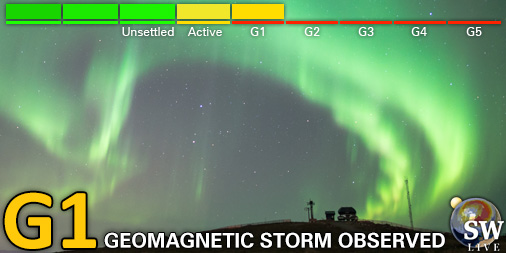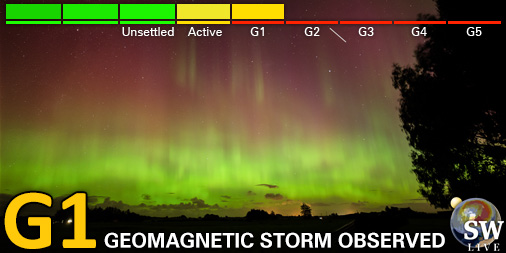Het archief bekijken van dinsdag 30 augustus 2016
Dagelijks bulletin over zonne- en geomagnetische activiteit van het SIDC
Datum verslag: 2016 Aug 30 1230 UTC
SIDC Prognose
Zonnevlammen
C-class flares expected, (probability >=50%)
Geomagnetisme
Active conditions expected (A>=20 or K=4)
Proton Flux monitor
Quiet
| 10cm flux | Ap | |
|---|---|---|
| 30 Aug 2016 | 086 | 008 |
| 31 Aug 2016 | 088 | 022 |
| 01 Sep 2016 | 091 | 011 |
Bulletin
Over the past 24 hours solar activity has been low. The largest flare was a C1.1 class flare. Active Region (AR) 2583 (Macintosh class:Dao; Mag. type:Beta) has been most active, producing the C1.1 class flare, which peaked at 17:36 UT yesterday. All other ARs have shown low levels of activity. AR 2583 still shows evidence of flux emergence and cancellation in HMI magnetogram observations which may increase flaring activity, however, the region is approaching the West solar limb. A filament channel located between N30W15 and N15W60 was observed to lift off around 19:00 UT yesterday in SDO/AIA 304 observations. The eruption did not produce a clear Coronal Mass Ejection (CME) signature in coronagraph observations, but there were significant data gaps in imagery. There is some evidence of a small CME moving off to West, which will have a small impact on the Earth system. Solar protons have remained at background levels over the past 24 hours. Solar activity is expected to remain low over the next 24 hours with a chance of C-class flares and a low probability of M-class flares.
The solar wind speed has increased from around 330 to 425 km/s over the past 24 hours. The total magnetic field strength has increased from around 5 nT to 10 nT. The Bz component has oscillated between positive and negative, fluctuating between -8 and +10 nT. Geomagnetic conditions ranged between Kp index 2-3 (NOAA) and local K index 1-3 (Dourbes) over the past 24 hours. A small trans-equatorial coronal hole located at central latitudes, N01W60, created enhanced solar wind speeds at Earth due to its associated high-speed stream (HSS), which are expected to persist throughout the day and may enhance geomagnetic activity. A large positive polarity Northern polar coronal hole located near central longitudes extending toward low latitudes is expected to enhance solar wind speeds in the coming days. As a consequence the geomagnetic activity is expected to be slightly enhanced today and again later in the week. The small filament eruption discussed above is expected to move to the West and avoid the Earth system.
Het geschatte internationale zonnevlekkengetal (ISN) van vandaag: 078, gebaseerd op 20 stations.Zon indexen voor 29 Aug 2016
| Wolfgetal Catania | /// |
| 10cm zonneflux | /// |
| AK Chambon La Forêt | /// |
| AK Wingst | 012 |
| Geschatte Ap | 010 |
| Geschat internationaal zonnevlekkengetal | 068 - Gebaseerd op 24 stations |
Overzicht opvallende gebeurtenissen
| Dag | Start | Max | Einde | Locatie | Sterkte | OP | 10cm | Catania/NOAA | Soorten radio-uitbarstingen | |
|---|---|---|---|---|---|---|---|---|---|---|
| Geen | ||||||||||
Aangeboden door het Solar Influences Data Analysis Center© - SIDC - Verwerkt door SpaceWeatherLive
Alle tijden in UTC
<< Keer terug naar de dagelijkse overview pagina
Op basis van de huidige parameters is er in de nabije toekomst een beperkte kans op poollicht op de volgende locaties van de gemiddelde breedtegraad
YakutskLaatste nieuws
Laatste forumberichten
Steun Poollicht.be!
Om ook bereikbaar te blijven bij grote poollichtkansen hebben we een zware server nodig die alle bezoekers aankan. Doneer en steun dit project zodat we online blijven en je geen enkele poollichtkans mist!

Laatste alerts
13:15 UTC - Geomagnetische activiteit
G1 - Kleine geomagnetische storm (Kp5) Drempel bereikt: 13:07 UTC
12:33 UTC - Hemisferisch vermogen
Het OVATION-model voorspelt dat het hemisferisch vermogen 75GW zal bereiken om 13:21 UTC
00:15 UTC - Geomagnetische activiteit
G1 - Kleine geomagnetische storm (Kp5) Drempel bereikt: 23:59 UTC
donderdag 3 april 2025
20:15 UTC - Geomagnetische activiteit
G1 - Kleine geomagnetische storm (Kp5) Drempel bereikt: 20:02 UTC
13:03 UTC - Hemisferisch vermogen
Het OVATION-model voorspelt dat het hemisferisch vermogen 50GW zal bereiken om 13:56 UTC
Ruimteweer feitjes
| Laatste X-klasse uitbarsting | 28/03/2025 | X1.1 |
| Laatste M-klasse uitbarsting | 01/04/2025 | M2.5 |
| Laatste geomagnetische storm | 27/03/2025 | Kp5 (G1) |
| Zonnevlekkenloze dagen | |
|---|---|
| Laatste zonnevlekkenloze dag | 08/06/2022 |
| Maandelijks gemiddeld zonnevlekkengetal | |
|---|---|
| maart 2025 | 134.2 -20.4 |
| april 2025 | 143 +8.8 |
| Afgelopen 30 dagen | 130.4 -16.1 |





